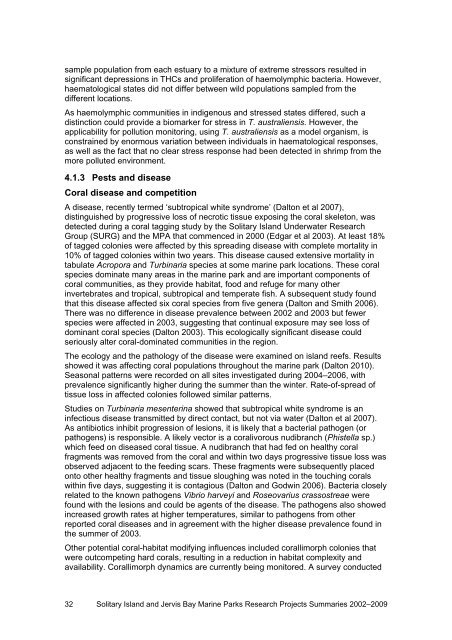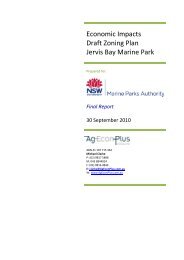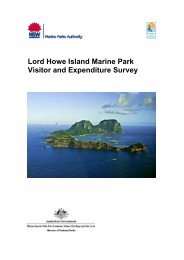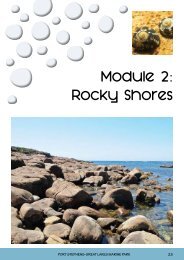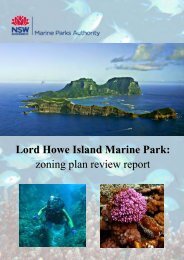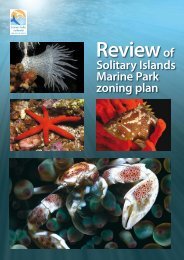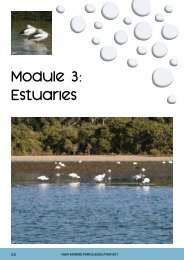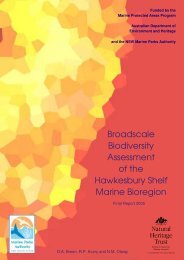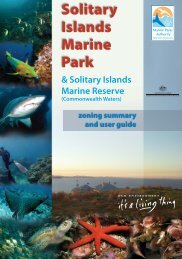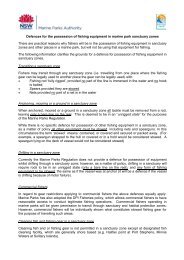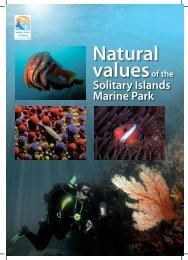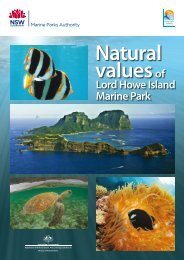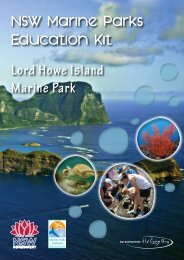Research Project Summaries 2002-2009 - Marine Parks Authority ...
Research Project Summaries 2002-2009 - Marine Parks Authority ...
Research Project Summaries 2002-2009 - Marine Parks Authority ...
You also want an ePaper? Increase the reach of your titles
YUMPU automatically turns print PDFs into web optimized ePapers that Google loves.
sample population from each estuary to a mixture of extreme stressors resulted insignificant depressions in THCs and proliferation of haemolymphic bacteria. However,haematological states did not differ between wild populations sampled from thedifferent locations.As haemolymphic communities in indigenous and stressed states differed, such adistinction could provide a biomarker for stress in T. australiensis. However, theapplicability for pollution monitoring, using T. australiensis as a model organism, isconstrained by enormous variation between individuals in haematological responses,as well as the fact that no clear stress response had been detected in shrimp from themore polluted environment.4.1.3 Pests and diseaseCoral disease and competitionA disease, recently termed ‘subtropical white syndrome’ (Dalton et al 2007),distinguished by progressive loss of necrotic tissue exposing the coral skeleton, wasdetected during a coral tagging study by the Solitary Island Underwater <strong>Research</strong>Group (SURG) and the MPA that commenced in 2000 (Edgar et al 2003). At least 18%of tagged colonies were affected by this spreading disease with complete mortality in10% of tagged colonies within two years. This disease caused extensive mortality intabulate Acropora and Turbinaria species at some marine park locations. These coralspecies dominate many areas in the marine park and are important components ofcoral communities, as they provide habitat, food and refuge for many otherinvertebrates and tropical, subtropical and temperate fish. A subsequent study foundthat this disease affected six coral species from five genera (Dalton and Smith 2006).There was no difference in disease prevalence between <strong>2002</strong> and 2003 but fewerspecies were affected in 2003, suggesting that continual exposure may see loss ofdominant coral species (Dalton 2003). This ecologically significant disease couldseriously alter coral-dominated communities in the region.The ecology and the pathology of the disease were examined on island reefs. Resultsshowed it was affecting coral populations throughout the marine park (Dalton 2010).Seasonal patterns were recorded on all sites investigated during 2004–2006, withprevalence significantly higher during the summer than the winter. Rate-of-spread oftissue loss in affected colonies followed similar patterns.Studies on Turbinaria mesenterina showed that subtropical white syndrome is aninfectious disease transmitted by direct contact, but not via water (Dalton et al 2007).As antibiotics inhibit progression of lesions, it is likely that a bacterial pathogen (orpathogens) is responsible. A likely vector is a coralivorous nudibranch (Phistella sp.)which feed on diseased coral tissue. A nudibranch that had fed on healthy coralfragments was removed from the coral and within two days progressive tissue loss wasobserved adjacent to the feeding scars. These fragments were subsequently placedonto other healthy fragments and tissue sloughing was noted in the touching coralswithin five days, suggesting it is contagious (Dalton and Godwin 2006). Bacteria closelyrelated to the known pathogens Vibrio harveyi and Roseovarius crassostreae werefound with the lesions and could be agents of the disease. The pathogens also showedincreased growth rates at higher temperatures, similar to pathogens from otherreported coral diseases and in agreement with the higher disease prevalence found inthe summer of 2003.Other potential coral-habitat modifying influences included corallimorph colonies thatwere outcompeting hard corals, resulting in a reduction in habitat complexity andavailability. Corallimorph dynamics are currently being monitored. A survey conducted32 Solitary Island and Jervis Bay <strong>Marine</strong> <strong>Parks</strong> <strong>Research</strong> <strong>Project</strong>s <strong>Summaries</strong> <strong>2002</strong>–<strong>2009</strong>


